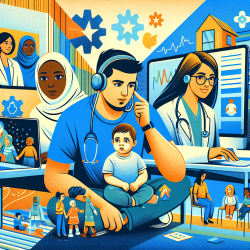Introduction
Urbanization is a transformative force reshaping cities worldwide, particularly in transitional economies like Myanmar. The study titled "Urbanization, Economic Development, and Environmental Changes in Transitional Economies in the Global South: A Case of Yangon" provides valuable insights into the dynamics of urban growth and its implications for various sectors, including speech-language pathology. This blog explores how practitioners can leverage these insights to enhance their skills and improve outcomes for children in urban environments.
Understanding the Context of Yangon
Yangon, Myanmar's largest city, has experienced rapid urban expansion over the past three decades. The city's urban built-up land increased significantly from 1990 to 2020, primarily converting farmlands and green spaces into urban areas. This urban growth has been accompanied by environmental challenges, such as increased air pollution levels, particularly PM2.5 and NO2.
The study highlights the complex interplay between urbanization, economic development, and environmental changes. As practitioners, understanding these dynamics is crucial for addressing the unique challenges faced by children in urban settings.
Implications for Speech-Language Pathology
Urbanization brings about changes in the social and environmental contexts in which children develop. Increased population density, economic activities, and environmental stressors can impact children's communication development and necessitate tailored therapeutic approaches.
- Environmental Factors: Exposure to air pollutants like PM2.5 can affect cognitive and language development. Practitioners should be aware of these environmental risks and incorporate strategies to mitigate their impact on children's communication skills.
- Socioeconomic Influences: Economic development can lead to disparities in access to healthcare and educational resources. Speech-language pathologists should advocate for equitable access to services and consider socioeconomic factors when designing intervention plans.
- Cultural Considerations: Urbanization often brings cultural diversity. Practitioners should be culturally competent and sensitive to the linguistic and cultural backgrounds of the children they serve.
Encouraging Further Research
The study of Yangon underscores the need for further research into the effects of urbanization on speech-language development. Practitioners are encouraged to collaborate with researchers to explore how urban environments influence communication disorders and to develop evidence-based interventions tailored to urban populations.
Additionally, integrating data-driven approaches and leveraging technology, such as online therapy platforms like TinyEYE, can enhance service delivery and accessibility for children in urban areas.
Conclusion
Urbanization presents both challenges and opportunities for speech-language pathologists. By understanding the implications of urban growth and its environmental and socioeconomic impacts, practitioners can better support children's communication development in urban settings. Embracing data-driven practices and advocating for research will ensure that speech-language pathology services remain effective and relevant in rapidly changing urban landscapes.
To read the original research paper, please follow this link: Urbanization, economic development, and environmental changes in transitional economies in the global south: a case of Yangon.










